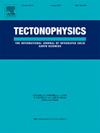利用水平 P 波反射率的对比来绘制大陆岩石圈的底部:美国中部和东部的研究结果
IF 2.7
3区 地球科学
Q2 GEOCHEMISTRY & GEOPHYSICS
引用次数: 0
摘要
由可移动阵列(TA)台站记录的 16 次地震的全球相位生成的垂直入射地震反射剖面显示了美国中部和东部地幔最上层 P 波反射率的独特模式。使用符号检验统计量对自引导叠加数据进行客观识别后发现,反射的总体分布与岩石圈-岩石圈边界(LAB)深度从大约 110 千米向西增加到 250 千米相一致,在岩石圈下部以水平 P 波反射率升高的片断连续段为标志。在某些剖面上,反射率增高区的起点与地表波层析成像发现的最大负 S 波速度梯度的相应深度非常吻合,这表明 P 波反射率可用于帮助描述下岩石圈的特性。我们认为,水平反射率的垂直变化跨越了岩石圈-干流层的过渡,包含了一个广泛的分层区,该分层区是由下岩石圈应变增加以及干流层阻力引起的流动造成的。其中一些线路还显示出波形,这些波形位于重叠 Sp 接收器函数剖面中被确定为岩石圈中层不连续面(MLD)的到达深度范围内。在 TA 线中观测到的反射波形大多是多周期的,极性混杂,表明出现了分层过渡,这与以前的观测和模型研究相一致,后者表明随着入射能量主导频率的增加,单个 Sp 波形会分解为一系列不那么突出、周期较短的 P 波反射。本文章由计算机程序翻译,如有差异,请以英文原文为准。
Using contrasts in horizontal P-wave reflectivity to map the base of the continental lithosphere: Results for the central and eastern U.S.
Vertical-incidence seismic reflection profiles generated from global phases for 16 earthquakes recorded by stations of the Transportable Array (TA) show distinctive patterns of P-wave reflectivity in the uppermost mantle beneath the central and eastern United States. The overall distribution of reflections identified objectively using the sign test statistic applied to bootstrapped stacks is consistent with a westward increase in depth of the lithosphere-asthenosphere boundary (LAB) from roughly 110 to 250 km that is marked within the lower lithosphere by piecewise continuous segments of elevated horizontal P-wave reflectivity. For some profiles, the onsets of zones of increased reflectivity closely match depths corresponding to the maximum negative S-wave velocity gradients found by surface-wave tomography, suggesting that P-wave reflectivity can be used to help characterize properties of the lower lithosphere. We suggest that the vertical change in horizontal reflectivity straddles the lithosphere-asthenosphere transition, encompassing a broad zone of layering caused by increased strain in the lower lithosphere as well as drag-induced flow in the asthenosphere. Some of the lines also show waveforms that fall within the depth range of arrivals identified as midlithospheric discontinuities (MLDs) in overlapping Sp receiver-function profiles. The reflection waveforms observed in the TA lines are mostly multicyclic with a mix of polarities indicating a layered transition, consistent with previous observations and model studies that show the breakup of single Sp waveforms into a series of less prominent, shorter-period P-wave reflections as the dominant frequency of incident energy is increased.
求助全文
通过发布文献求助,成功后即可免费获取论文全文。
去求助
来源期刊

Tectonophysics
地学-地球化学与地球物理
CiteScore
4.90
自引率
6.90%
发文量
300
审稿时长
6 months
期刊介绍:
The prime focus of Tectonophysics will be high-impact original research and reviews in the fields of kinematics, structure, composition, and dynamics of the solid arth at all scales. Tectonophysics particularly encourages submission of papers based on the integration of a multitude of geophysical, geological, geochemical, geodynamic, and geotectonic methods
 求助内容:
求助内容: 应助结果提醒方式:
应助结果提醒方式:


